Understanding Payment Applications in Complex and Crucial Surety Claims Investigations
When the time comes to evaluate a project as part of a contract surety claim investigation, there is no such thing as too much information. For surety claims professionals, applications for payment, also known as “payment applications” or “pay apps,” can provide immense value regarding the progression of a project and the corresponding payments provided. In this post, we provide some fundamental guidance for surety claims professionals on how to interpret these documents for use in claims investigations and look at:
- The types of information typical in payment applications
- How contract accounting summaries can help forecast project completion timelines, regardless of what the contractor says
- Schedules of value (SOVs): what’s included and how to use them
- Certificates of Payment and other documents that may be useful to sureties
The Application for Payment: The Basics
Payment applications are commonly used during construction to invoice clients or project owners for work performed. They vary slightly from a standard invoice in that they:
- typically are an itemized request for funds associated with work performed
- are submitted periodically, most commonly on a monthly basis, so that a contractor can be paid for progress made on a project
- include extensive backup documentation, such as schedules of value, project schedules, lien releases, certified payroll, or other items as required by the contract
- are verified by the client or their representative before payment is issued
While the exact process and requirements for issuing an application for payment varies from one project to the next, these are typically listed in the Division 1 “General Requirements” section of the project specifications.
Several different types of applications for payment are utilized on projects. The most commonly used form is the standard American Institute of Architects (AIA) form G702 Application for Payment (Fig. 1 below). The AIA form contains:
- Project information
- Period of time covered by the pay application
- Contract accounting summary
- Contractor’s certification of the value being requested for payment
- Architect’s certification for payment
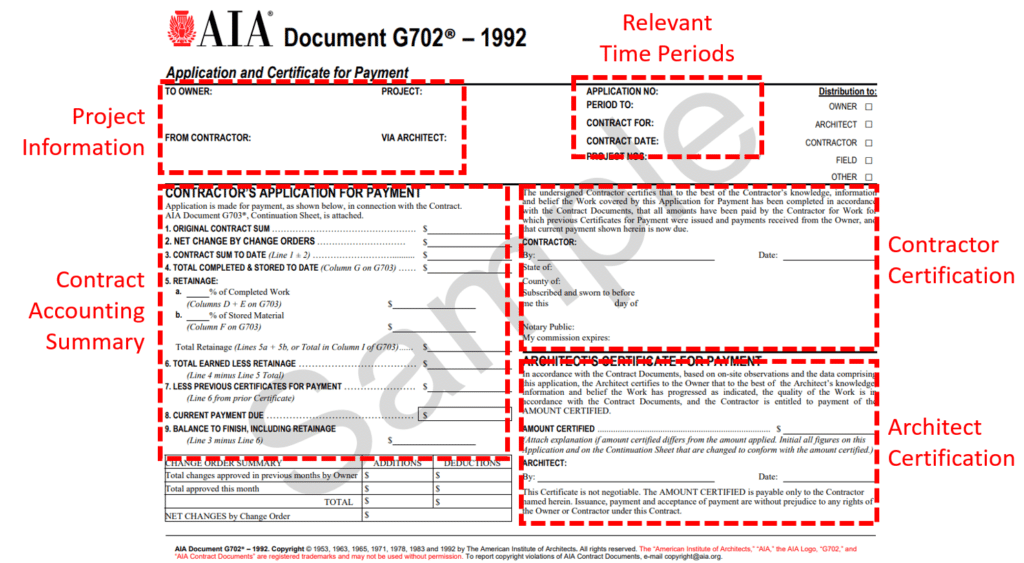
Figure 1: Standard AIA form G702 Application for Payment
For projects administered by the US Army Corps of Engineers, “Eng Form 93” is typically used on most US military projects (Fig. 2 below). Although graphically different, the form includes much of the same information as the AIA form listed above. One difference: the government entity administering the contract submits the form after supporting documentation has been provided by the contractor and approved, as opposed to the AIA form, which is directly prepared by the contractor.
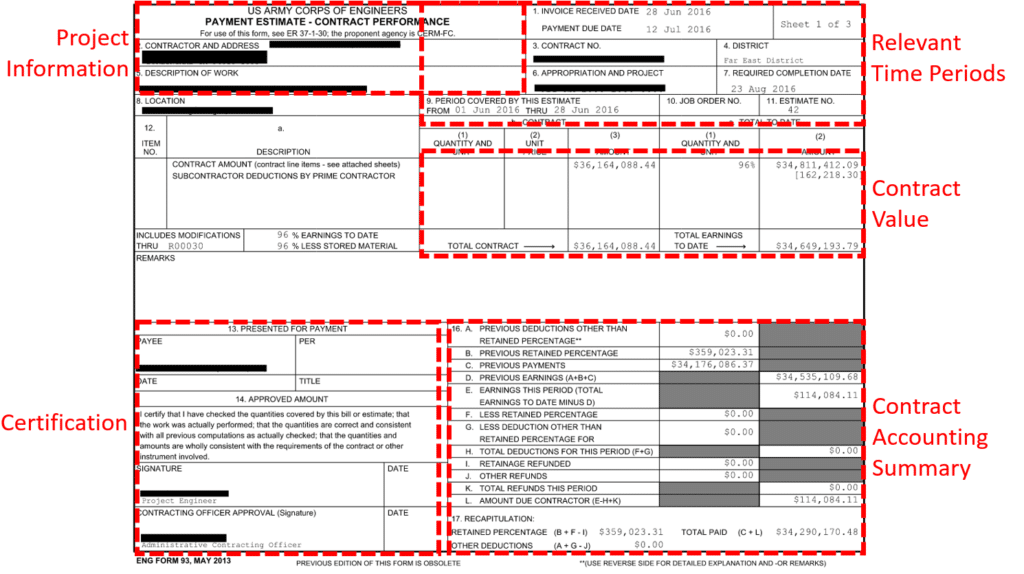
Figure 2: Eng Form 93
Often times, private entities such as large developers, or state and local governments, will develop a unique application for payment form. These are quite often based on the AIA form, and then tweaked to meet the needs of the particular party or public agency. Fig. 3 below represents a payment application from the Miami-Dade County municipality, containing most of the same information as the other examples.
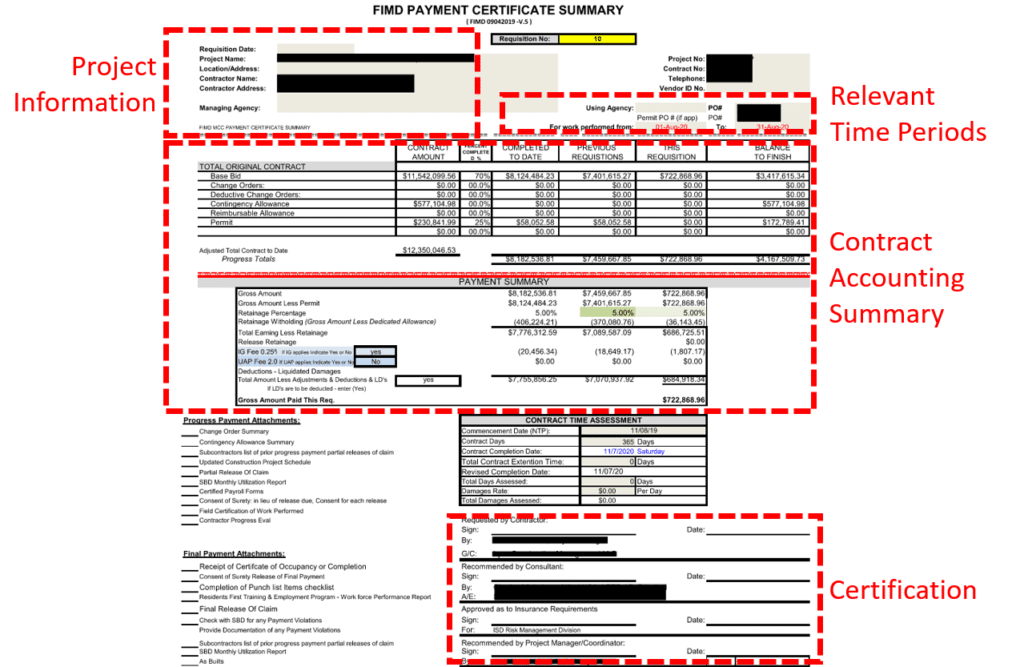
Figure 3: Miami Dade County Payment Application
These standard project documents contain a wealth of information that can be helpful in evaluating a project as part of an investigation into a contract surety claim. Much of the information is included directly in the pay application and other data can be easily inferred from or calculated based on the information provided.
Drilling Down: Contract Accounting Summaries
Valuable information can be gathered from the contract accounting summary. Below is an excerpt from an AIA pay application.

Figure 4: Sample Contract Accounting Summary
Valuable insights include:
Contract changes: The contract accounting summary included in a payment application provides information on the current contract value. After a bond has been issued, the surety might not hear anything about the contract for a long period of time, or until something goes wrong. In the contract accounting summary, the surety can find insight into changes to the contract issued to date, thus arriving at a revised total contract value, which in the example is $1,667,436.50, reflecting a significant increase to the original bonded contract value.
Retention amounts: Retention is a percentage of the value of each pay application that may be withheld, or retained, from the contractor in an effort to protect the Owner against overpayment for defective or incomplete work. Essentially, it is a value that has been earned but will not be paid until the end of a project. The value of retention, if any, is specified in the contract documents, and typically ranges from 5-10% of the value earned. Retention is often passed down to lower tier contractors and vendors. In Fig. 4 above, the retainage value is 5% of the value of work completed, so the total value withheld to date is $71,277.20.
It is usually to the benefit of the surety that retention is held, provided the rate isn’t so high that it chokes the contractor’s cash flow. This retained value should typically be available to the surety to put towards completion efforts. A failure of the obligee to retain the funds as specified in the contract could be deemed a breach of the contract for disadvantaging the surety in the event it is required to complete a project. Some of this value may be owed to lower tier subcontractors and vendors, so it could potentially also be used to resolve payment bond claims.
Work Status: The contract accounting summary also reveals much information about the status of the work on the project. Some application for payment forms show an actual percentage of the work that is complete, but it is fairly easy to calculate when that information is not included. There are essentially two ways of looking at the status of the work from a value standpoint:
- The “balance to earn” demonstrates the actual value of work yet to be completed. This is calculated simply by subtracting the value completed-to-date from the total contract value. In Fig. 4 above, the balance to earn would be:
$1,667,436 – $1,425,544 = $241,892
- The “contract balance” calculates the value of funds remaining in the contract, which the surety typically has available to work with in order to complete a project or to offset its costs towards completion, and includes retention and any other unpaid or withheld values. This is calculated by subtracting the value paid-to-date from the total contract value, which in Fig. 4 above would be:
$1,667,436 – $1,340,492 = $326,944
Evaluating Progress: Contractor Rate of Production
Beyond the basic figures in an application for payment, the contract summary can also shed light on the contractor’s schedule performance in terms of the rate of production.
In Fig. 5 below, the Miami-Dade County pay application payment certificate summary, surety can determine approximately how fast a contractor is earning the contract funds relative to its overall contract duration, and thus compare the rate of production to the overall allowable contract duration.
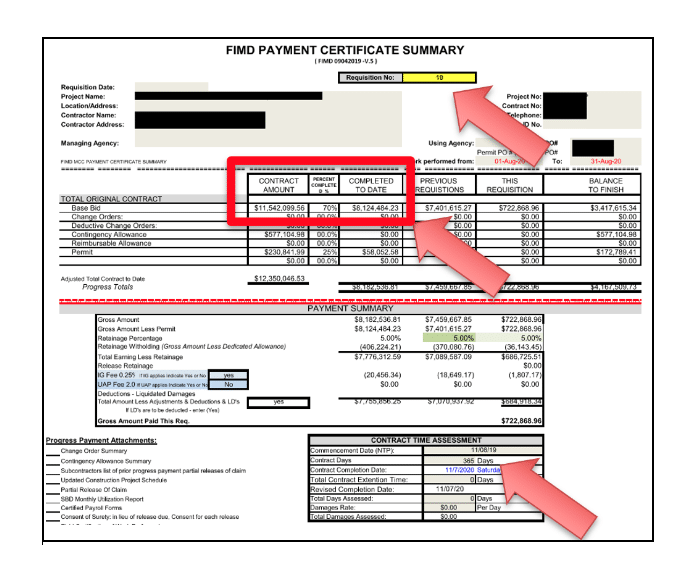
Figure 5: Payment Certificate Summary
This is application for payment No. 10, as highlighted in yellow near the top of the Fig. 5 above. Since Payment Applications are submitted on a monthly basis, and at the end of each month, this application for payment likely represents 10 months of work performed by the contractor. Near the bottom of the form however, the total contract time listed is 365 days, equivalent to 12 months. Thus, the contractor has used roughly 10 out of 12 months, or approximately 83%, of the available contract time.
By dividing the value of work completed-to-date by the total contract value in Fig.5 above, we can see that the work is 70% complete in terms of its billing (as compared to 83% of the contract time being utilized, as discussed above). Conveniently, this form lists the percentage complete so a calculation isn’t necessary. With 10 months complete, this translates to a rate of production of 7% per month. With only two months remaining in the contracted period of performance, the contractor would need to increase the rate of production to 15% of its contract value per month – more than double the current rate – to complete the project on time.
While this calculation isn’t an exact science, it does provide the surety with a glimpse into the ability of a contractor to complete a project within their required schedule, or how much of an uptick in production would be required to do so.
There is more to be found beyond the glimpse provided by this rough calculation. Realistically, contract funds are not earned on a straight-line basis. Typically, contract earnings follow an S-Curve, the name of which is taken from the shape of the graph when earnings are charted throughout the course of a project, as seen in Fig. 6 below. Normally, it takes a while for project earnings to ramp up, as it takes time for a contractor to mobilize, prepare initial submittals, order materials, and start putting work in place. Production ramps up when a contractor is constructing the bulk of the work. Most often, this is the actual physical construction activities which carry the most value, including labor, materials, and heavy equipment. As the project nears the finish, earnings tend to drop, as efforts tend to shift towards equipment start-up, testing, commissioning, punch list completion, and closeout activities, which require less labor, and very few materials and equipment.
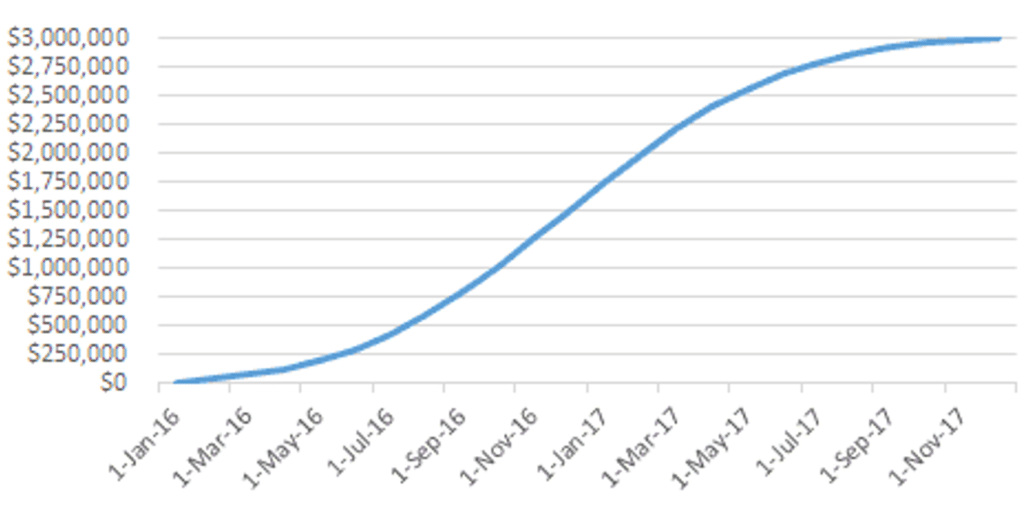
Figure 6: Contract Earnings S-curve
So what does this mean for the contractor with 30% of the contract funds remaining to be earned with only 17% of the contract time remaining? It is likely that an even larger increase in the rate of production would be required in order to achieve the deadline, as earnings typically wind down in the last few months.
At this point, its important to note that all of the data on the rate of production in the Miami-Dade County pay application payment certificate summary was taken from a single application for payment. If a history of applications for payment is available for a project, a much clearer picture emerges of the contractor’s month-over-month production. Mapping out the actual production rate assists with identifying trends, which can help forecast when a project is likely to be completed, independent of what the contractor may relaying to the surety. Having a reasonably accurate estimated completion date can help with estimating:
- potential liquidated damages
- contractor overhead costs, and
- cash flow requirements
It may also inform a surety’s decision as to whether to make an additional investment, such as augmenting a contractor’s labor force. Again, this data can be gathered simply by looking at the contract accounting summary in the pay application rather than by undertaking a detailed schedule analysis.


Figure 7: History of Payment Applications Simplify Insight Gathering
The contract accounting summaries are the backbone of an application for payment. Information captured in these documents give sureties a foundational view on projects in progress – for better or for worse. In addition, the insight goes a very long way to informing investigations should a claim arise.
Schedule of Values: The Basics and How they Work for Surety Claims
A Schedule of Values, also known as an “SOV,” is typically included with an application for payment. The SOV includes a detailed breakdown of the payment that the contractor is applying for, and generally includes:
(1) a list of separate items of work included in the contract
(2) a total value associated with each of the items of work and
(3) the value of each of the items of work that has been completed to date.
Often, more detailed information is provided.
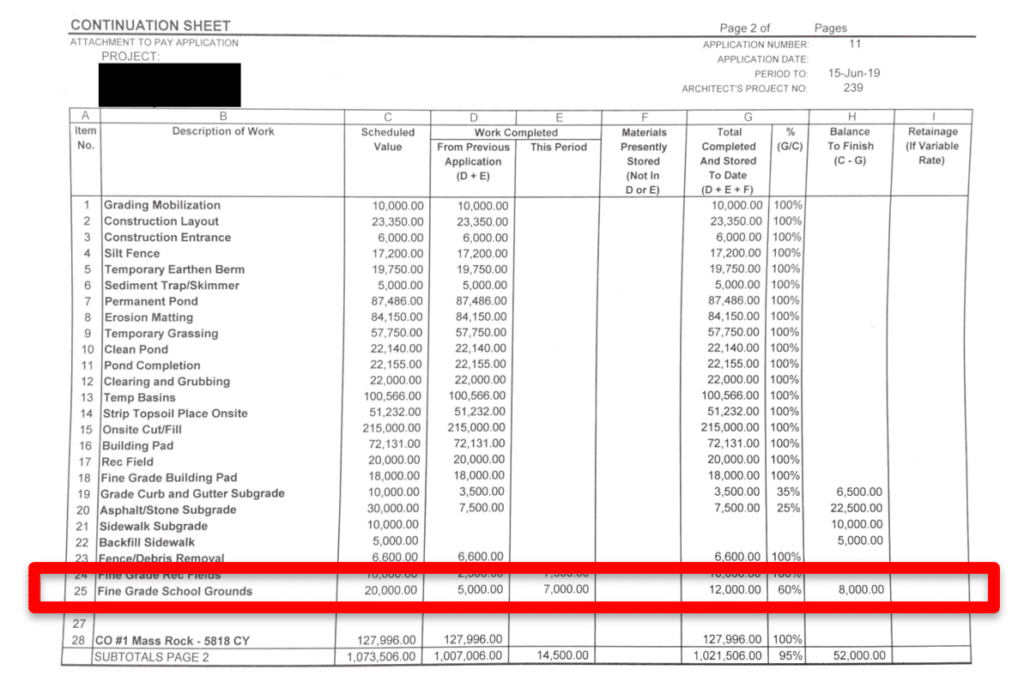
Figure 8: A Typical Schedule of Values
The SOV is prepared by the contractor prior to submitting the first invoice, and it is reviewed and approved by the owner or contract administrator. Sometimes, the SOV is relatively simple, as shown in Fig. 8 above from an earthwork and grading subcontractor. Other times, the SOV may contain hundreds, or even thousands, of individual line items for very specific components of the contracted work. The most crucial aspect is that the sum of individual line items totals the entire contract sum, thus allowing a means for the contractor to invoice for the full contract value.
When making a progress application for payment, the contractor will
- estimate the total value of each line item completed,
- subtract what was completed during previous months and
- arrive at the payment value being sought for the particular period
Using the SOV shown in Fig. 8 as an example, we find that Item No. 25 is for “Fine Grading at the School Grounds.” The total value for this line item was agreed to be $20,000. The contractor had previously invoiced for $5,000 and is requesting an additional $7,000 for this period. Thus, the contractor is estimating that it has completed $12,000, or 60%, of the total value of this work item. This process is then completed for each individual line item to determine a total value of work completed, and thus a value that is owed to the contractor.
Beware the Common Practice of Front Loading the SOV
While “front loading” of a SOV is a common practice used by contractors to increase cash flow at the beginning of a project, it can be problematic for a surety. Essentially, this is a billing practice where a contractor will try to place an unreasonably high proportion of the total costs into line items that will be invoiced early in the project, thereby de-valuing items to be completed late in a project in order to collect as much cash as possible early in the project cycle. This often occurs in line items such as “mobilization” to the project site or other early activities, such as demolition or site preparation work. This can be problematic for the surety, because if a demand is made upon the bond, there may be very little contract funds remaining complete the work if it was all paid for in early construction activities. If particularly obvious, it may also be evidence of an overpayment made by the Owner or Obligee.
A very clear example of front loading is exemplified in Fig. 9 below. The physical work being performed by a subcontractor was divided into four fairly equal phases. As shown here, the subcontractor valued the first phase of the work at over $774,000 and the remaining three phases at just over $41,000. This was clearly done in an attempt to collect as much cash as possible after the first phase of work. The subcontractor also severely overvalued the cost of preparing product data submittals, and undervalued the cost of shop drawings and closeout documents. Unfortunately for the surety, the general contractor accepted this schedule of values and paid for the first phase of work. The subcontractor was subsequently terminated before completing any of the remaining phases, leaving a contract balance that was severely deficient to complete the remaining work. In this case, the front loading is so blatantly obvious that it likely represents an overpayment made by the Obligee.

Figure 9: Front Loading the SOV Can Be Problematic for Sureties
SOVs Can Limit the Risk Caused by Overpayment or Underpayment
There are other ways that the SOV can help a surety determine whether payment for work performed has been properly calculated, including both overpayments and underpayments.
In some cases, overpayments are obvious, and an obligee clearly should have known that a contractor was overbilling for a value of work completed. Fig. 10 below is an excerpt from the same schedule of values shown in Fig.8 above. The “Onsite Cut and Fill” line item, which might also be referred to as “rough grading,” was billed and paid as 100% complete, which should mean that all of the earthwork was graded within a few inches of its final elevation.

Figure 10: Payment in Full Should Equal a Job Complete
Well and good, except that the photo below (Fig. 11) below was taken from the project site after the Payment Application was paid. The individuals are standing in the middle of a roadbed that was allegedly 100% complete with rough grading. Clearly, this is not accurate, as there was a three-foot drop in the middle of the roadbed, yet the obligee approved payment to the earthwork subcontractor for this line item. They now expected the surety to cover the costs of completing this work after the subcontractor had been terminated. This instance provides an excellent example of how a SOV provides critical information that a surety can use to review whether proper payment had been made.

Figure 11: A Job Paid For, Yet Not Completed
It can also be problematic when an obligee is underpaying a contractor. This may unfairly restrict the contractor’s cash flow and quickly lead to project delays. Fig. 12 below shows a contractor’s SOV that had been marked up by the contract administrator.
Looking closely, the administrator circled ten items and wrote a relatively generic note to reduce payment by half for each of these line items. While it is possible that, after careful review, the administrator determined that each of these line items was being billed at precisely double the value of what had actually been installed. It is more likely, however, that the administrator was being a bit lazy and simply reduced a whole series of line items because he or she believed that they were being billed at too high of a value. The result is a somewhat arbitrary and unfair reduction of payment to the contractor. In this instance, the total value being reduced is relatively minor, but this often happens on a much larger scale. Watching for instances like this may be useful to a surety while investigating a claim against the bond, since not paying for work performed by the contractor may be a breach of the contract terms by the Obligee.

Figure 12: Underpayments May Represent a Breach of Contract
SOVs and Payment Bond Claim Reviews
A surety may also use the SOV as evidence to support payment, or denial of payment, to a payment bond claimant. As an example, assume that a surety receives a claim from a structural steel supplier asserting that they had only been paid for half of the steel provided to a project site. Fig. 13 below shows an excerpt from an application for payment from a general contractor to an owner showing that the contractor had previously invoiced for all of the structural steel components for a project. Based on this information, we know that the owner has approved payment of the steel materials. Conversely, the owner has only paid for roughly 76% of the steel erection, so it can be assumed that the erection work has not yet been completed and approved by the owner. While there may be other relevant information for a surety in reviewing a payment bond claim, understanding whether items have been approved and paid for by the owner can certainly be of assistance.
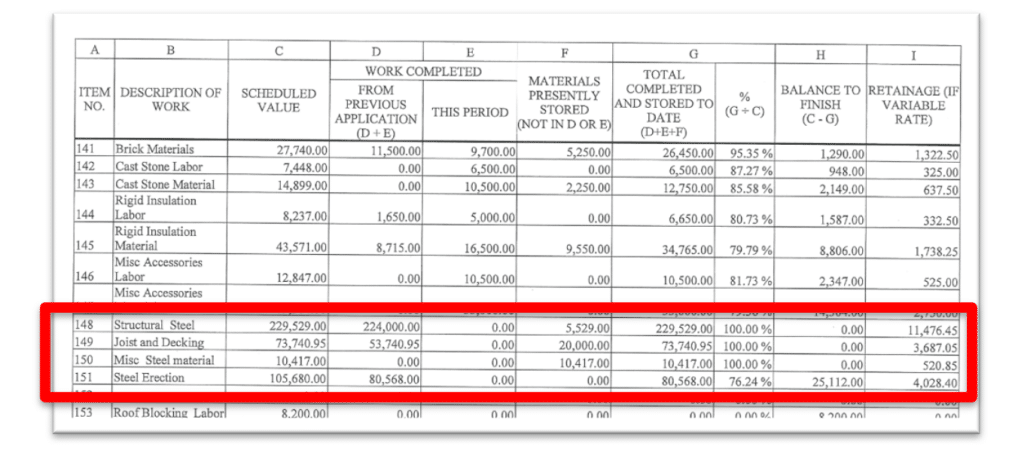
Figure 13: SOVs May Provide Evidence Needed to Support or Deny Payment Bond Claims
There’s More: Get to Know the Certification for Payment
Another aspect of an application for payment that a surety may find useful is the certification for payment. As noted earlier when reviewing examples of different application for payment forms, this may be found in different formats. Fig. 14 and Fig. 15 below are from the standard USACE form and the AIA form. In both cases, both the contractor and the contract administrator certify that, to the best of their knowledge, the pay application is an appropriate representation of the actual work completed.

Figure 14: USACE Certification for Payment

Figure 15: AIA Certification for Payment
There are a few important items to note regarding the certification for payment.
- First, if a party signs an application for payment with knowledge of misrepresentation, it could arguably be considered a false claim.
- Second, the AIA form is certified by the Architect, who in theory is a third-party administrator of the contract, implying more objectivity in the review of the application for payment than if it were being reviewed by the party responsible for payment.
- Finally, if the corresponding AIA contract documents are utilized on the project, including the form A201 General Conditions, the owner is essentially required to make payment once the Architect certifies the application for payment. Thus, lack of payment within a specified period after certification could be deemed a breach of contract.
Want to Dig Deeper? Other Documents that Sureties May Find Useful
Often times, a contract will require that other documents be submitted on a monthly basis along with the application for payment in order for it to be considered for payment. While not covered in detail here, the following documents may also be useful to a surety:
- Construction Schedule Update: may contain a wealth of information regarding the contractor’s ability to complete work in a timely manner, as well as the likelihood of preparing successful claims. The schedule updates may also be required documentation if the surety wishes to prepare delay-related claims.
- Subcontractor Lien Waivers: may help with the review of payment bond claims, or with the preparation of ratification agreements in the event of a surety takeover.
- Certified payrolls: may confirm the values paid to a contractor’s employees, which may be especially useful in a matter where the surety may be considering financing the contractor.
The surety role and responsibility – especially in cases where claims arise – is complex and requires a great deal of diligence. In this post, we touched on some of the more useful ways that applications for payment can be utilized in the review of contract surety claims. Should you wish to learn more ways that documents prepared as part of the administration of a contract can assist a surety in the analysis of a claim, please reach out to the author directly at sreed@vertexeng.com or call 781.952.6000.



